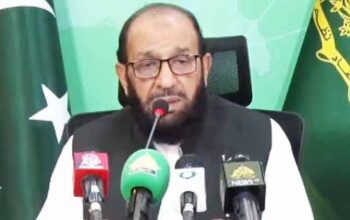The digital census was supposed to be the epitome of transparency and accuracy, but the fantastic numbers it is turning up beggar demographers’ belief.
By Muhammad Ali
ISLAMABAD: If the picture emerging from fresh census data is to be believed, the relative share of Punjab in the country’s population is down by 4.1 percent, and that of Balochistan up by 2.5 percent.
Officials close to the number crunching exercise say Pakistan’s total population has gone up from 207.7 million in the 2017 census to 239 million in 2023, reflecting a growth of 15 percent during the two comparable periods.
Based on these numbers, the country’s annual population growth calculates to 2.4 percent, which is not too surprising. Less digestible to demographers is the divergence between the population growth rates of provinces.
This is yet another anomaly thrown up by the as yet unpublished data returned by what is being dubbed as the country’s first digital census, and likely to add to the controversies already surrounding the exercise.
Related: Can census results arrive in time for polls in Oct ’23
This implies, among other things, that going forward, the relative share of Punjab in the federal divisible pool under the National Finance Commission (NFC) Award will fall, and that of Balochistan will rise commensurate to the new population numbers. In particular, for the first time, Punjab’s share will fall below 50 percent.
In the NFC Award announced in 2010, the share of Punjab stood at 57 percent on the basis of population. The relative share of the province in the country’s population fell in the census held in 2017, and accordingly, its share in the divisible pool slid to 53 percent. If the data being cited from the new census is correct, this share is set to diminish again.
According to the fresh census data, the population of Sindh increased from 47.9 million in 2017 to 54.9 million in 2023, witnessing a surge of 14.6 percent over the intervening period. The overall growth rate of the population in Sindh stood at 2.3 percent.
Sindh’s share in the overall population of the country remained stagnant as it stood at 23 percent in both comparable census periods held in 2017 and now ongoing in 2023.
The population of Khyber Pakhtunkhwa has increased from 35.5 million in the 2017 census to 39.4 million in accordance with census results of 2023, witnessing a growth of 10.9 percent over the period.
The overall growth rate of the population in KP stood at 1.7 percent. However, the share of Khyber Pakhtunkhwa in the overall population of the county declined from 17.1 percent in 2017 to 16.5 percent.
The population in Balochistan increased from 12.3 million in 2017 to 20.1 million in 2023, witnessing a surge in population growth by 62.9 percent over the intervening period. Annual population growth rate of the province tallies in at a hefty 8.5 percent.
The relative share of Balochistan in the country’s population witnessed a massive surge, rising from 5.9 percent in 2017 to 8.4 percent in 2023.
Apart from the share in the federal divisible pool, provincial job quotas are also calculated based on the relative population share of provinces.
Owing largely to these and other systemic incentives attached to population, a census is usually a controversial exercise in Pakistan, with parochial forces vying to inflate their numbers and political parties jumping into the fray on the side of their home province or division.
Another issue may be that the workforce of enumerators for counting purposes is provided by provincial governments, and unscrupulous parochial influences gaining a foothold in provincial structures cannot be ruled out.
There were widespread hopes that the census now underway, designed to take advantage of modern technologies to ensure accuracy and transparency, would gain equal acceptance across the nation.
That ideal, however, seems to be slipping away because of all the anomalies detected in the data so far. It now seems that without changing the problematic incentive structures, Pakistan’s hopes of holding a transparent census will remain unfulfilled.
With political parties from all provinces in its fold, The ruling Pakistan Democratic Movement (PDM) may be well placed to address these issues once and for all.
However, the government has its hands full with the array of economic and political problems facing the country and it is not clear at this point if and how it intends to tackle the problem.
On the other hand, the census numbers will also be primary to districting for the upcoming general elections, and any delay in the announcement of the census results may lead to a delay in elections.
Copyright © 2021 Independent Pakistan | All rights reserved




